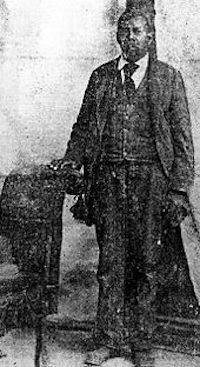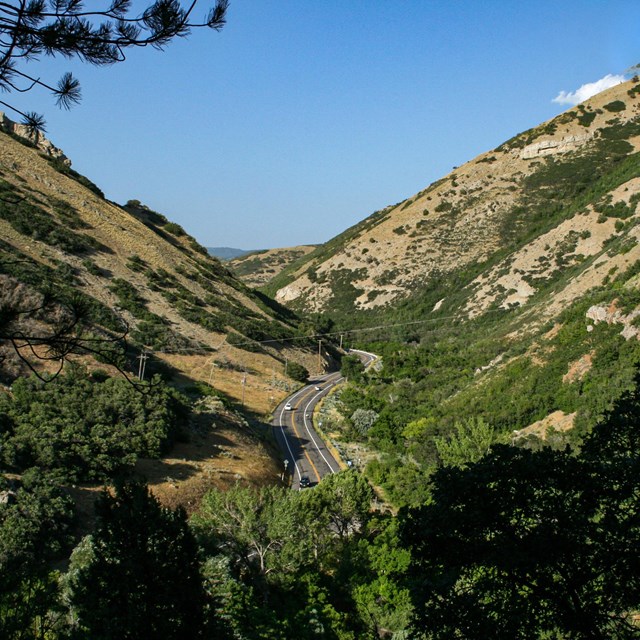Part of a series of articles titled People of the Mormon Pioneer Trail.
Article
Green Flake, the Mormon Pioneer Trail

Image/Public Domain
Green Flake – Mormon Pioneer Trail[1]
By Angela Reiniche
Green Flake was born into slavery on 6 January 1828 on the Jordan Flake Plantation in Lilesville, Anson County, North Carolina. His master, Jordan Flake, gave ten-year-old Green to his son James Madison Flake as a wedding gift when he married Agnes Love in 1838. James and Agnes moved shortly thereafter to Mississippi with their three-year-old son, taking along Green and their other slaves. They intended to help colonize land that had been opened to white settlers following the government’s forced removal of several American Indian communities to present-day Oklahoma. While in Mississippi, the Flake family and their enslaved servants met Elder Benjamin Clapp, a Mormon missionary, and joined The Church of Jesus Christ of Latter-day Saints. John Brown, a Mormon missionary assigned to Mississippi, noted in his diary on 7 April 1844 that “we ordained two elders the same day, brother James M. Flake & Washing[ton] N. Cook. I also baptized two Black men, Allen & Green, belonging to Brother Flake.”[2] Green Flake had joined the church during a time when Church President and Prophet Joseph Smith proposed to free all the slaves in the United States. After Smith’s assassination just two months later, Brigham Young assumed leadership of the church and, a year later, began organizing a mass migration of the Latter-day Saints to resettle in the American West.
The Flake household, which pledged to follow in Young’s footsteps, traveled first to Nauvoo, Illinois, in 1844, where the church accepted Green’s labor as part of the Flake family tithing. When Young led the first LDS wagon companies out of Nauvoo in 1846, three Mormon families from Mississippi volunteered their enslaved men – Green Flake, Oscar Crosby, and Hark Lay – to go along as laborers. (Flake, at the time, weighed nearly two hundred pounds and was respected as a laborer.) Brigham Young instructed that his vanguard party, which would be followed by the rest of the saints fleeing Nauvoo later in the spring, should include the slaves Green Flake, Oscar Crosby, and Hark Lay to chart the path into the Salt Lake Valley and to prepare homes for the oncoming families. The journals kept by company members, therefore, consistently referred to Flake, Crosby, and Lay. These African American men made vital contributions during the pioneer trek, with Flake acting as Brigham Young’s personal wagon driver.[3]
Flake made particularly significant contributions during the final days of that trek. When Brigham Young lay ill at the head of Emigration Canyon, nearly at the threshold of the Salt Lake Valley, Green was one of a select few chosen to forge ahead to prepare the road into the valley. Green drove the first wagon into Emigration Canyon, and by the time Young arrived in the valley a few days later, Green had already planted crops. Soon afterward, Flake proved to be enormously helpful to his immediate masters. When James and Agnes Flake arrived in the Salt Lake Valley in October 1848, they found that Green had built them a comfortable log cabin in the Holladay area of the Salt Lake Valley, about ten miles from the main settlement of Salt Lake City.[4]
James Madison Flake died in 1850, not long after Young had ordered the Mississippi Saints to leave Holladay and establish a new colony in California at Rancho San Bernardino. Agnes Flake, her sons, and Lizzy Flake (one of their other slaves, unrelated to Green) made their home in California until Agnes died from a long-term illness in 1854. Green Flake, for reasons unknown, did not make the move to California. Agnes experienced financial struggles after the death of her husband; she asked Amasa Lyman, a church elder who had organized the Holladay settlement and the move to San Bernardino, to write to Brigham Young to ask him to sell Green to raise funds for her family. No sale took place, however, and Green may have considered himself free. Some church histories suggest that when James Madison Flake died in 1850, Green was given to Brigham Young, who then freed him.[5]
By this time, Green Flake had married Martha Crosby, who had been baptized into the Church of Jesus Christ of Latter-day Saints while enslaved by the Crosby family in Mississippi. Green and Martha had two children, Lucinda and Abraham, and the family remained in Union (a few miles southwest of Holladay) until the late 1890s. They farmed there and joined Hark Wales (formerly Hark Lay) and other members of the Crosby’s extended family as they pursued mining ventures. The 1860 census for Salt Lake County, post office Union, recorded an entry for the Flake family: Green Flake, his wife Martha, and their two children, Lucinda (5) and Abraham (almost a year). Green’s occupation was listed as a “common laborer,” and most of their neighbors were of the same occupation or listed as “farmers.”[6] Ten years later, according to census records, Lucinda and Abraham remained in their parents’ household, living next door to another Black pioneer, Miles Litchford, and his family. Two years later, in June 1862, Flake and his family were emancipated when Congress eliminated slavery in all U.S. territories. Flake and Litchford, along with several other African American Mormon pioneers, worked together in the mining industry during the 1870s.[7]
Shortly after Young and the main body of Saints arrived in the Salt Lake Valley, the church began to exclude Black men from the priesthood and restrict Black Mormons’ access to the temple. Green, despite his changing status after arriving in the Salt Lake Valley, remained devoted to the church. He carved a gravestone for his wife after her death in 1885. Above her name is etched in now weather-worn and barely legible text: “In my Father’s house are many mansions.” This invocation echoed the sentiments Joseph Smith preached the day Green was baptized: “There [are] many mansions in my father’s Kingdom. What have we to console us in relation to our dead? We have the greatest hope in relation to our dead of any people on earth. We have seen them walk worthy on earth and those who have died in the faith are now … gone to await the resurrection of the dead, to go to the celestial glory.”[8]
Late in his life, Green Flake, who was proud of his role as a Mormon pioneer, often appeared and gave speeches at local celebrations. In 1896, Green moved to Gray’s Lake, Idaho, to be near his children and grandchildren, but he often returned to Salt Lake City to join in the Jubilee Pioneer Day celebrations. An 1894 newspaper account described the surviving pioneers and proclaimed that “one of the most interesting of these old-timers was Green Flake, the only colored survivor of the band of ’47. Green is a vigorous, broad-shouldered, good-natured, bright old gentleman, long a resident of Salt Lake County, but now living at John Gray’s Lake, Idaho. He wears glasses, but that is the only sign of old age about him. His voice might do for a trumpet, and he steps off like a West Pointer when he walks.”[9] Green Flake died in Gray’s Lake, Idaho, on October 20, 1903 and was buried next to Martha at Union Cemetery in Salt Lake City. Green’s service as a Mormon pioneer is memorialized, along with Oscar Crosby and Hark Lay, on the Brigham Young statue, as it is known, in downtown Salt Lake City; it celebrates the vanguard company – and its three African American members – who paved the way for the Latter-Day Saints into the Salt Lake Valley.
[1] Part of a 2016–2018 collaborative project of the National Trails- National Park Service and the University of New Mexico’s Department of History, “Student Experience in National Trails Historic Research: Vignettes Project” [Colorado Plateau Cooperative Ecosystem Studies Unit (CPCESU), Task Agreement P16AC00957]. This project was formulated to provide trail partners and the general public with useful biographies of less-studied trail figures—particularly African Americans, Hispanics, American Indians, women, and children.
[2] John Zimmerman Brown, Journal of Pioneer John Brown (Salt Lake City: Daughters of Utah Pioneers, 1941).
[3] “Fifty Years Ago Today,” Salt Lake Tribune, 31 May 1897; and Jonathan A. Stapley and Amy Thiriot, “‘In My Father’s House are Many Mansions’: Green Flake’s Legacy of Faith,” Church History, The Church of Jesus Christ of Latter-Day Saints, accessed 12 June 2017, https://history.lds.org/article/green-flake-pioneer?lang=eng.
[4] “More Pioneers,” Deseret News, 19 July, 1897; Stapley and Thiriot, “‘In My Father’s House.’” In the records of the LDS Pioneer and Handcart Companies, 1847–1856, Green Flake is listed as having been part of the “First Pioneer Company of 1847.” LDS Pioneer and Handcart Companies, 1847–1856 [database on-line] (Provo, Utah: Ancestry.com, 2013).
[5] Stapley and Thiriot, “‘In My Father’s House;’” and Margaret Young Blair, “Green Flake, 1828–1903,” Black Past, accessed May 23, 2017, http://www.blackpast.org/aaw/flake-green-1828-1903.
[6] 1860 Census, Place: Salt Lake, Utah Territory; Roll: M653_1313; Page: 44; Family History Library Film: 805313. 1860 United States Federal Census [database on-line] (Provo, Utah: Ancestry.com Operations, Inc., 2009).
[7] 1870 Census, Place: South Cottonwood, Salt Lake, Utah Territory; Roll: M593_1611; Page: 522B; Family History Library Film: 553110. 1870 United States Federal Census [database on-line] (Provo, Utah: Ancestry.com Operations, Inc., 2009).
[8] Stapley and Thiriot, “‘In My Father’s House.’” According to Stapley and Thiriot’s notes, census records placed Green Flake’s birth between 1825 and 1828. His gravestone states 1828. Newspaper articles at the time of his death noted that he was 76 years old, which would indicate a date of 1826 or 1827. Near the end of his life, Green noted that he was “Born in north Car[o]lina, “ at “mads burr” [probably Wadesboro], Anson County, North Carolina. Green Flake, “Reminiscences,” in Utah Semi-Centennial Commission, The Book of the Pioneers [ca. 1897], quoted in “Mormon Pioneer Overland Travel, 1847–1868”; and John Brown, “Reminiscences and Journals,” April 3–7, 1844, p. 27, microfilm of holograph, MS 1636, LDS Church History Library, Salt Lake City, Utah.
[9] “The Veterans’ Reunion,” Salt Lake Herald, 21 August 1894.
Last updated: March 10, 2023


